![]() Back in December, I received one of the American Teacher Awards from Disney
and McDonald's Corporations. There was a party for me at a local
McDonald's restaurant. At the party, Jane Strauss, one of the members of
our local school board, spoke at length with Ingrid Roper, Clyde's wife.
Back in December, I received one of the American Teacher Awards from Disney
and McDonald's Corporations. There was a party for me at a local
McDonald's restaurant. At the party, Jane Strauss, one of the members of
our local school board, spoke at length with Ingrid Roper, Clyde's wife.
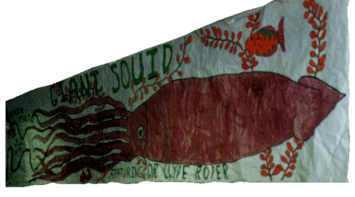 She also toured the school and my classroom where we were setting up the
Giant Squid Expedition Herndon Outpost. I explained our problem with
getting e-mail and Internet access. Ms. Strauss became very excited about
the project and promised to do what she could to make our dream a reality.
Within three days, we were hooked up to the Internet.
However, Clyde, Ingrid, and the expedition team had left for
Kaikoura. They took with them my home e-mail address in hopes
that I could relay journals and messages to the class.
She also toured the school and my classroom where we were setting up the
Giant Squid Expedition Herndon Outpost. I explained our problem with
getting e-mail and Internet access. Ms. Strauss became very excited about
the project and promised to do what she could to make our dream a reality.
Within three days, we were hooked up to the Internet.
However, Clyde, Ingrid, and the expedition team had left for
Kaikoura. They took with them my home e-mail address in hopes
that I could relay journals and messages to the class.
February arrived and we were ready to hear from the expedition. We brought the In Search of Giant Squid Web Page up each day on the classroom computer to see if anything had been posted. I raced to my own computer each evening after putting my kids to bed to see if there were any messages. Nothing. Clyde had mentioned his itinerary would involve a couple of weeks of checking equipment and gathering the team, so we weren't too worried.
![]() In the meantime, we wrote letters of encouragement and made drawings of the
research team studying the sperm whales and giant squid.
We sent this first batch to the marine laboratory at Edward Percival Research Station on
Kaikoura Peninsula.
In the meantime, we wrote letters of encouragement and made drawings of the
research team studying the sperm whales and giant squid.
We sent this first batch to the marine laboratory at Edward Percival Research Station on
Kaikoura Peninsula.
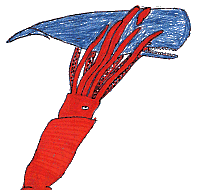 The students drew cartoons with giant squid
characters, scenes of sperm whales eating giant squid, and scenes of
Clyde's team in action. I told them that a large part of the expedition
would be to monitor equipment and wait.
The students drew cartoons with giant squid
characters, scenes of sperm whales eating giant squid, and scenes of
Clyde's team in action. I told them that a large part of the expedition
would be to monitor equipment and wait.
When the first e-mail from Clyde came we couldn't wait to read it. I
photocopied it for the whole team, along with Clyde and Ingrid's vivid
journals of their adventures thus far. We were ravenous for news.
"Did he find the giant squid?" rang through the halls of our
middle school. I smiled, shook my head no, and handed them the
e-mail message.
 It had to be translated. It was classic Clyde,
full of good New England humor, "advanced scientific" terminology ("We
saw a ..... whizz-by"), updates on their boats, Tanekaha and the
Mystique, the automated underwater vehicle, the Odyssey, and
details of their preparations. It was fascinating.
It had to be translated. It was classic Clyde,
full of good New England humor, "advanced scientific" terminology ("We
saw a ..... whizz-by"), updates on their boats, Tanekaha and the
Mystique, the automated underwater vehicle, the Odyssey, and
details of their preparations. It was fascinating.
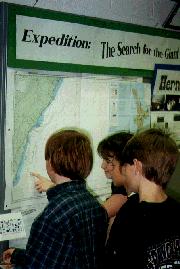 The students were learning firsthand, almost as if they were there,
about:
The students were learning firsthand, almost as if they were there,
about:
No textbook could do this, although I'd like to
see the journals and e-mail messages in a textbook one day. This was
real and happening right now. The expedition was accessible. The
students sensed they were a part of history.
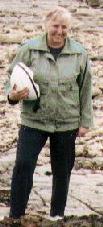 I decided then to make Ingrid's journals the source material for
our study of parts of speech and summarization. From then on, we printed Ingrid's journals and Clyde's e-mail messages.
Ingrid's journals were beautifully written, worthy of National Geographic
or Smithsonian publications.
I decided then to make Ingrid's journals the source material for
our study of parts of speech and summarization. From then on, we printed Ingrid's journals and Clyde's e-mail messages.
Ingrid's journals were beautifully written, worthy of National Geographic
or Smithsonian publications.
I never knew this wordsmith side of her. She
seemed to genuinely enjoy the writing as well, which was a wonderful model
for my students.
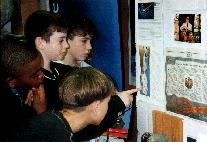 Clyde later wrote e-mail messages directly to our team, often inserting
teachable moments ("Think about your answer to that question I just asked
before reading futher for the answer"). He asked us to look up words he was
using. He responded to specific students by name (from their own e-mail).
He told us how much our letters and support meant to his team, and he
encouraged student studies. He also reminded us that there was more to
life than giant squid.
Clyde later wrote e-mail messages directly to our team, often inserting
teachable moments ("Think about your answer to that question I just asked
before reading futher for the answer"). He asked us to look up words he was
using. He responded to specific students by name (from their own e-mail).
He told us how much our letters and support meant to his team, and he
encouraged student studies. He also reminded us that there was more to
life than giant squid.
They say that education only occurs when there is conflict. If that's the case, we learned a tremendous amount on the day we received an e-mail from Clyde explaining what happened with the crittercam operation and with the beached sperm whales.
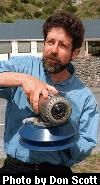 Clyde explained that the weather had been unusually windy and cold for
summer in New Zealand (They are in the Southern Hemisphere - seasonal
temperatures and moisture are the opposite for those in the Northern
Hemisphere).
Clyde explained that the weather had been unusually windy and cold for
summer in New Zealand (They are in the Southern Hemisphere - seasonal
temperatures and moisture are the opposite for those in the Northern
Hemisphere).
![]() He explained that animal rights groups had protested their
efforts to attach the crittercams to the tops of sperm whales. The suction
cups weren't enough, however, for the wrinkled and moving skin - tiny hooks
were used to "grab" the upper epidermis. The protesters thought this was
abusive. Eventually, the expedition team received a 15-month permit to
use the suction cups to attach the cameras to the whales.
He explained that animal rights groups had protested their
efforts to attach the crittercams to the tops of sperm whales. The suction
cups weren't enough, however, for the wrinkled and moving skin - tiny hooks
were used to "grab" the upper epidermis. The protesters thought this was
abusive. Eventually, the expedition team received a 15-month permit to
use the suction cups to attach the cameras to the whales.
The class debated the merits of obtaining scientific knowledge at the possible expense of pain to an animal or testing subject. We felt pretty sure the whales wouldn't feel the tiny hooks, but debated as if the whales could feel a bit of pain -- Which is the greater priority: discovery or comfort of animals?
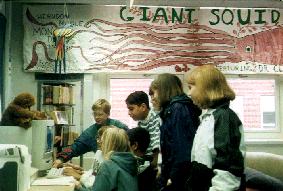 The second controversy was even more stirring. Clyde wrote to us of five
beached sperm whales found along the shore. The scene moved him deeply.
We gathered around the computer
and viewed the multiple images of those whales available on the
Kaikoura module on the National Geographic website. The students were silent at
first, listening to Clyde's words. They saw the haunting images of the
huge carcasses, mouths agape in a final struggle against gravity, and Clyde
and Malcolm standing next to them on the misty shoreline.
The second controversy was even more stirring. Clyde wrote to us of five
beached sperm whales found along the shore. The scene moved him deeply.
We gathered around the computer
and viewed the multiple images of those whales available on the
Kaikoura module on the National Geographic website. The students were silent at
first, listening to Clyde's words. They saw the haunting images of the
huge carcasses, mouths agape in a final struggle against gravity, and Clyde
and Malcolm standing next to them on the misty shoreline.
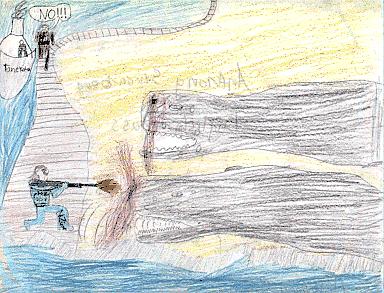 The controversy was over animal euthanasia. Moments before, Clyde and the
bioacoustical team heard that two of the whales were still alive. They
raced to the beached whales to obtain a few minutes of recordings of the
whale signals. Evidently, sperm whale recordings are very rare.
While they pleaded their case to
get their recordings, they heard the rifle shots that killed the final two
whales. The officials put the two creatures out of their misery. No one
spoke as I read the e-mail describing those moments. I also shared Tom
Allen's observations from the National Geographic dispatches.
The controversy was over animal euthanasia. Moments before, Clyde and the
bioacoustical team heard that two of the whales were still alive. They
raced to the beached whales to obtain a few minutes of recordings of the
whale signals. Evidently, sperm whale recordings are very rare.
While they pleaded their case to
get their recordings, they heard the rifle shots that killed the final two
whales. The officials put the two creatures out of their misery. No one
spoke as I read the e-mail describing those moments. I also shared Tom
Allen's observations from the National Geographic dispatches.
![]() Clyde and his team were allowed to examine the whales' bodies afterwards.
They found repeated evidence of encounters with giant squid and other types
of squid. Clearly defined sucker marks were scattered across whale skin.
Many of them had healed quickly due to the saltwater, Clyde explained on
the dispatch.
Clyde and his team were allowed to examine the whales' bodies afterwards.
They found repeated evidence of encounters with giant squid and other types
of squid. Clearly defined sucker marks were scattered across whale skin.
Many of them had healed quickly due to the saltwater, Clyde explained on
the dispatch.
There was a third setback. Earlier, it become clear that the automated
Odyssey had limitations maneuvering in the rocky
and uncertain terrain of the underwater canyon. Between this, the beached
whales and the crittercam issues, it seemed to the students as if
the expedition team kept getting close to finally encountering the giant
squid, only to have "the rug pulled out from under them," forcing another
long wait. We learned a new word that day: "elusive". The images of the
sucker welts were exciting, however. We knew the expedition was in the
right area.
![]()
Smithsonian Giant Squid Overview Page
gene carl feldman / gene@seawifs.gsfc.nasa.gov